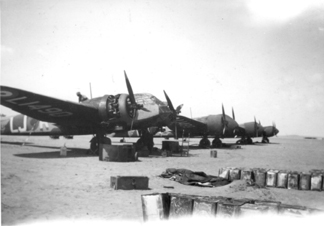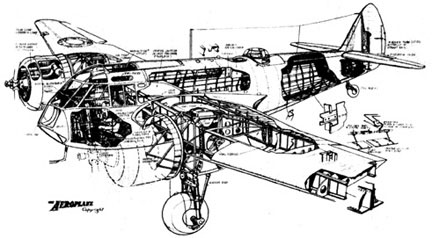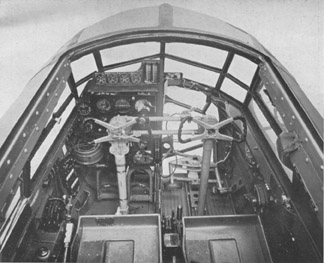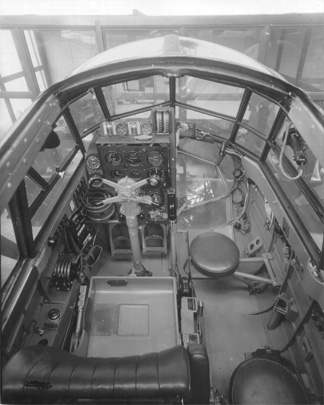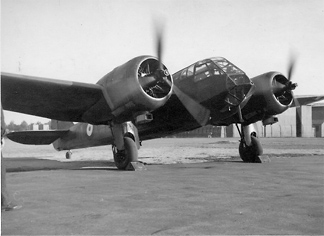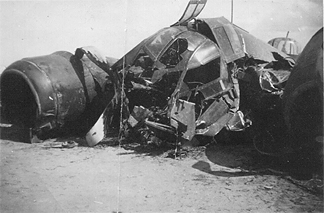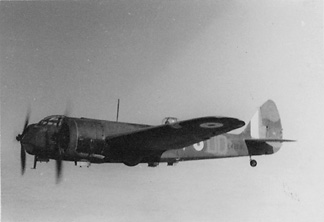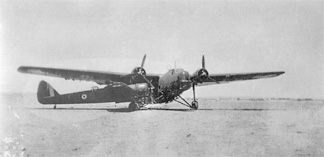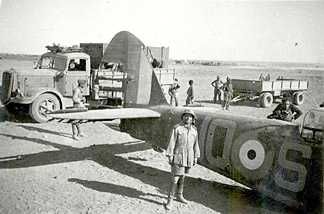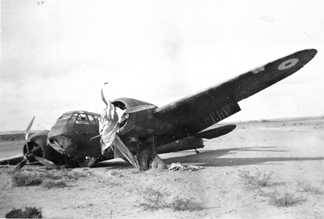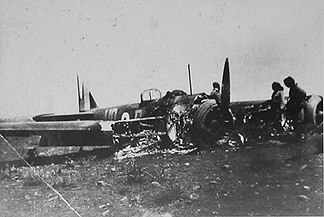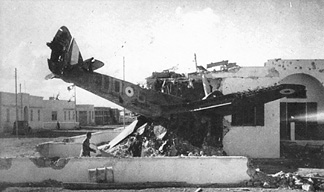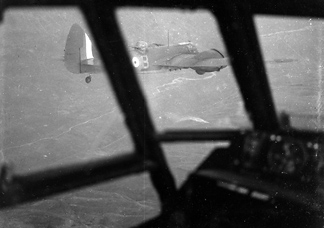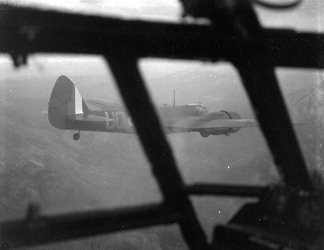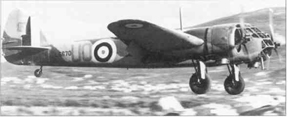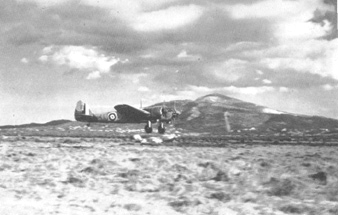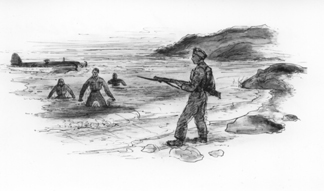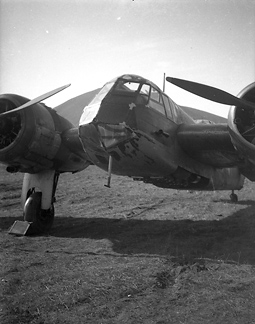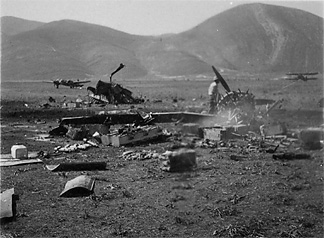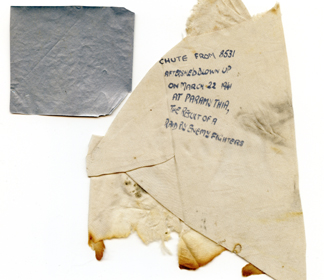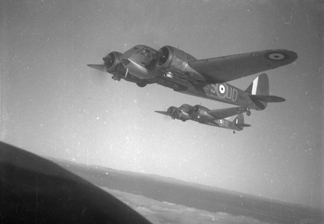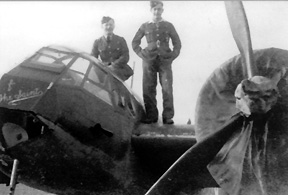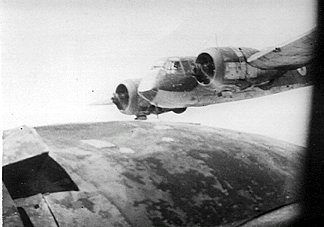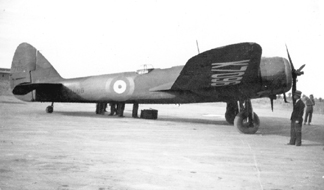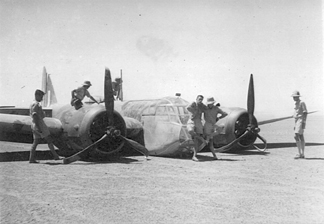 |
 |
||||||||||||||||||||||||||||||||||||||||||||||||||
|
Bristol Blenheim I (Type 142M) The 1930s background
L1490 LJ-R leading. This aircraft survived operations from June 1940 in the Western Desert to March 1941 in Greece. In Britain, the metropolitan airforce grew rapidly with the successive expansion plans of the period, the Blenheim for example being one element of Expansion Scheme C of May 1935 and confirmed in Scheme F of February 1936, aiming to be ready to fight an air war against Germany by the Spring of 1939. In the flurry of rapid growth, the Air Ministry and Air Staff struggled to juggle resources and to rethink requirements as better designs came into being through the specification system and through private venture. Here, too, lay the roots of somewhat confused progress among the sound, the not so sound and the ill-judged, with fatally slow development for some projects (like the Fairey Hendon and the Boulton Paul Defiant), effectively none for others pressed into production (like the Fairey Battle), and comparatively speedy development for others (like the Armstrong-Whitworth Whitley and the Blenheim). Bristol beginnings Among the so-called Press Barons of the early 20th Century United Kingdom, the Harmsworth brothers were prominent if not pre-eminent as owners of The Daily Mail, The Times, and The Daily Mirror. The younger of the two, Lord Rothermere, had earlier been the first Secretary of State for the Royal Air Force in the turbulent World War I period under Lloyd George. Still actively interested in aviation, Bristol's Type 135 design for a 2 crew, 6 passenger twin (2xBristol Aquila) came to Rothermere’s attention in 1934, his interest in a fast British-built personal transport having been piqued by the order of fellow media magnate Beaverbrook—for a Lockheed 12 from America. In the end, after some cautious discussion with both the Air Ministry and with the press baron, Bristols offered and in March 1934 Rothermere ordered the up-rated Type 142 private venture (2xBristol Mercury), which as built became his personal aircraft Britain First. This, the sole Type 142, was donated by its owner to the Air Ministry shortly after delivery. The original Bristol Type 135 design was never built, proceeding instead to a further development, the Type 143 with 2xAquilas and slightly enlarged to 8 passengers plus 2 crew. A single Type 143 was built in parallel with the Type 142. A militarised transport version of the Type 143 was also proposed (the Type 143F with 2 Mercury IX). With an interchangeable nose/armament option and provision for a “free-mounted Lewis” in a dorsal position, the Type 143F design attracted the attention of the Finnish government who opened negotiations to buy 9 of the type. However, the Finnish proposal was overtaken by the RAF's initial order for 150 of the Type 142M Blenheim (which the Finns subsequently both bought and license built). Likewise, Bristols were unable to take up Rothermere's offer to order a replacement for his donated Type 142. Blenheim development The task was a major redesign: of the wing centre-section and fuselage (raising the wing to mid-fuselage to provide for a bomb-bay stressed for 1,000lbs); of the nose (to provide navigating and bomb-aiming positions beside the pilot); of the rear fuselage (to add the dorsal turret and radio operator's position); of provision for all the associated military equipment (turret hydraulics, flares, bombing and gunnery hardware, radio, hatches, dinghy, external hard points); raising the tailplane by 8", and re-stressing the airframe for military use. Result: a 19% increase in empty weight (from 6,300lb to 8,100lb), for a 2,400lb or 24% increase in all-up weight (to 12,200lb, although weight reports vary). A major redesign, by any standard. Development was quick in the sense that production orders were placed straight off-plan: that is, off the Type 142M plans. Following the Britain First first flight at Bristol Filton in April 1935, Bristol's July 1935 Type 142M proposal was met with Air Ministry Spec B.28/35 (bomber) in August, incorporating the modifications described above and followed immediately by the first production order for 150 aircraft. The first flight of the Type 142M/Blenheim I prototype K7033 took place on 25 Jun 1936, 14 months after the Britain First flight. Service trials followed, and the design was given final production approval in December 1936. The first service delivery (K7036) on 10 March 1937 was just short of 2 years development since the "Britain First" flight, and not far short of 4 years from Barnwell's initial twin design. Successful conversion: no doubt. Quick? Perhaps. A tribute to Barnwell's expertise? Certainly. But let's not pretend it was simple. The fabled top speed of 307 mph (and more realistically, of 285 mph with maximum load) were in fact those achieved by Britain First, and in its as-delivered condition. Mischievously, Jane's 1938 edition quoted the latter as the Type 142M/Blenheim I top speed, often re-quoted since, alongside the equally unattainable 295mph for the Mark IV. While the new design was expected to offer much better performance than RAF bombers then in service, Bristols were more realistic: in November 1935 their advice to the Air Ministry was that the Blenheim might reach 268mph (maximum speed, presumably) and “that it would be able to carry its 1,000lbs of bombs for 810 miles and home [sic] at 234mph and for 980 miles at 200mph” Although there was some temptation among the Air Staff at the time to treat the 268mph as if that were a realistic all-occasions speed with war-load, on service entry the more practical estimates that Bristols had put forward were not far off the mark. In war conditions, after hard use, all such speeds would be rather less. Development summary
Into service
For the period between its service entry in March 1937 and the arrival of Hawker Hurricanes in 111 Squadron at Christmas that year, the Blenheim was as fast as any fighter in the RAF. Bristol figures show, for production Blenheim Mark Is, a maximum full-load speed of 279 mph at 15,000 ft and of 265 mph at 10,000 ft. For the Mark IV, Bristol data show a maximum speed of 266 mph at 11,800 ft. By 1941, ageing operational aircraft could not have achieved such speeds in level flight. In action, fully laden aircraft on a long sortie might cruise at 180 mph or 200mph for an endurance of around 5 hours. At high power settings, the consumption of the Mercuries made daunting inroads into the 280 gallon fuel capacity of the Mark I. While cruising with the mixture set fully lean, you might eke out 40 gallons of 87 octane an hour but pull on +5lb of boost in rich mixture to dodge an unwelcome visitor and you might be looking at 160 gallons an hour or more (though the Mark VIII Mercuries were only rated to stand this treatment for 5 minutes!). By the time Mark IV Blenheims entered service at home in early 1939, Mark Is had found their way to the Middle East and the Far East. By 1940 in Europe, and by 1941 overseas, the Blenheim's place as a fast medium day bomber had been eclipsed by later developments. Under-bombed, under-gunned and under-powered, Mark Is and Mark IVs alike were obsolescent if not obsolete. Even so, the Blenheim had been built in large numbers and was very active in the early part of the RAF’s war. Operating in every conceivable role and in literally every Home and Overseas Command, the Blenheim recorded many “firsts”, apart from the early technical achievements already noted. Its service as the first radar night fighter may stand as exemplar for them all. With the Battle of Britain and the beginning of Luftwaffe night bombing attacks, 6 RAF Squadrons were equipped with Blenheim IFs converted to the night fighter role, fitted successively with Aerial Interception (AI) Mark I, III and IV radar sets. At the time, a nimble multi-seat twin was highly desirable as a night fighter, the early AI radar sets weighing around 600 lb. The first successful radar night interception was achieved by a Fighter Interception Unit Blenheim IF with AI Mark IV on 22/23 July 1940, guided to AI range by Ground Controlled Interception (the standard technique). The Blenheims continued radar night fighter operations with modest success until April 1941, even as Beaufighters were being introduced. As radar development continued, Blenheim Mark IFs with obsolete AI sets accompanied Mark IV bombers on offensive night intruder operations over occupied Europe. The Blenheim paid the price for being conceived in that period of rapid development which saw it arrive as the premier medium day bomber of the time (with the similarly tasked Battle its contemporary), just as equally radical development in fighter design was bearing fruit. The Air Ministry and the Air Staff had contemplated and successfully encouraged rapid development of high speed monoplane bomber and interceptor designs virtually simultaneously in 1934,1935 and 1936. The tension between urgent need to expand with modern equipment, the rationale for pressing ahead with lightly armed day bombers in quantity, all while developing eight-gun fighters capable of destroying them: these issues were certainly recognised by the Air Staff, the Cabinet and their various Committees considering the re-armament levels and aims of Schemes F and H through 1936 and 1937. The issues were complex: firepower, bomb load, weight, range, production volume and production lead times were all in play—among a host of other concerns. In the end, the sort of medium bomber that the Blenheim represented was a compromise: it was what was available to produce in 1937, in numbers sufficient over the next few years to be ready for a war in 1939. Their defence was seen to lie in speed, powered turrets, and defensive formations. If the powered turret of the Blenheim was then at the forefront of technology, the entry to service of high speed, single-seat multi-gun monoplane fighters was soon to render the lightly defended fast medium day bomber role untenable for the time being. Speed, power, armament and endurance all advanced very greatly in those few short years before war finally came again to Europe. All were to advance again in the press of war. Blenheim Is in the Middle East and Far East When Italy entered the war in June 1940, the RAF Middle East order of battle included nine Blenheim squadrons:
In India and the Far East at the same date Nos, 34, 60 and 62 Squadrons operated Blenheim Is. For No. 27 Squadron, it was to be November 1940 before their mixed bag of Wapitis, Harts and Tiger Moths could be exchanged for Blenheim IFs (the fighter version, created by the addition of a four Browning gun belly pack under the bomb bay). By May 1941, RAF Middle East had at its disposal the following 11 Blenheim Squadrons:
In December 1941, Japan opened hostilities across the Far East and Pacific. Re-equipped in strength with Mark IVs, 84 Squadron and 211 Squadron (now released from 72 OTU duties) were in transit to the Far East from mid to late January 1942. 113 Squadron had already departed the Middle East in early January with their sixteen Mark IVs, to operate from Burma. There they were joined in February by 45 Squadron to fight against the advancing Japanese until forced to withdraw to India. By March 1942, disaster had befallen the Blenheim Squadrons in the struggle for Singapore, Sumatra and Java (Nos 27, 34, 60 (Mark Is and Buffalos), 62 (Mark Is and Hudsons), 84 and 211 (Mark IVs); and for Burma (45 and 113 Squadron, Mark IVs). Transferring to Colombo that month, 11 Squadron (now with Mark IVs) also had anxious moments but survived. The best in-print sources recognise that the official records of the Far East units, their movements, their place in Orders of Battle are incomplete and occasionally in conflict, as are later interpretations of the state of play. It was a difficult period of World War II. By April 42, RAF Middle East was still operating Blenheim IV units at various posts in Egypt and the Western Desert, for example 203 Squadron, 55 Squadron, 14 Squadron. Specifications
211 Squadron Blenheim Is The date and place of 211 Squadron conversion from the Hawker Hind have each been variously reported, however, Jefford's date of April 1939 is that recorded in the Squadron operations record book: by mid-April 1939 S/Ldr JWB Judge had collected the first aircraft, at Ismailia (very possibly the dual-control aircraft, one of which they certainly received as part of the conversion process).
A Bristol works shot, taken pre-war to illustrate the firm’s quite lavish booklet “Bristol” Blenheim Bomber. In late April, the Squadron moved briefly to its war-station at El Dabaa before returning to Ismailia on 1 May to complete the conversion. By the end of the month they had taken all 18 Blenheims on charge from the Aircraft Depot, RAF Aboukir (12 as Initial Equipment and 6 as their Immediate Reserve). A busy and somewhat frustrating period followed, as the Squadron also undertook servicing of newly-arrived Blenheims air-ferried in from the UK by Blenheim Delivery Flights, consequent local ferrying duties, servicing of its own Blenheims while addressing local equipment difficulties; and limited flying of its own machines. Still, by July 1939 their training programme was in full swing, though they were still bedevilled with technical shortages, particularly of W/T sets for the aircraft and of the tools and servicing equipment needed for maintenance.
The best Mark I cockpit shot in existence, from Len Cooper’s fine collection: he had worked for the Bristol Aeroplane Co. Here the aircraft is not only factory fresh, it is actually at the Bristol Filton works, one of a number taken for the firm’s booklet, as above. The Observer’s seat and his fold-down perch while at the bomb-sight are clearly shown. The aircraft may be ready for delivery, but ready for operational service it plainly isn’t. The bracket for the absent Mark IX bomb-sight can be made out on the lower right side of the instrument panel, likewise the wiring loom for the bomb selector unit yet to be fitted on the starboard fuselage side, right, beneath the forward glazing. By early August, whatever the problems, the tense political situation saw RAF ME Squadrons adopting a state of readiness and moving forward to their war stations. On 10 August, 211 Squadron returned to Daba and desert life. Meanwhile, Blenheim Delivery Flights from the UK to the Middle East continued, the air-ferry task offering an opportunity for a spot of adventure and Home leave for 211 Squadron aircrew. A number were detached to the UK for BDF duties, and these carried on until war broke out. The result of these late jaunts was, however, unfortunate from the Squadron’s point of view, as the two crews absent on BDF duty at 4 September were promptly shanghaied in the UK: F/O WH Edwards and P/O Pat Burnett, along with their Observers (Sgt Allan and LAC Tickner) and W/Ops (F/Sgt Horwood and AC W Wright). Edwards was promoted and went on to be decorated for his service in 2 Group until falling PoW. Burnett did eventually return to the Squadron, arriving on 4 January 1940 and command of 'B' Flight for a period, certainly flying in late February, and resuming as Adjutant on 21 March 1940. The last 211 Squadron ORB entry for him being a sortie on 23 April 1940 to search for a suspect submarine. Pat Burnett went on to serve elsewhere in the Desert and as an Instructor at Ismailia, before returning to the UK where he completed a further 45 sorties and was twice decorated (DSO, DFC) for his service with 44 (Rhodesia) Squadron and 9 Squadron. He retired an Air Commodore, and passed away in March 2004. It was February before Wright and Tickner were able to return, having wangled a Wellesley Delivery Flight back with ex-113 Squadron Sgt pilot Marpole, who joined 211 Squadron soon after. Blenheim Is in 211 Squadron service While these are good primary sources, they may nevertheless suffer omission or error (as may later accounts, despite the care taken in their compilation). Further, in the press of events, aircraft recorded as flown by 211 Squadron crews may not have been recorded elsewhere as on 211 Squadron charge, while aircraft on a Squadron’s charge may not appear in the Operations Record Book unless actually flown on an operation—and perhaps not even then. Drawing on these sources and on Operations Record Books for other units, the lists that follow have now been recast into the Squadron’s main operational periods and reconciled once more against the invaluable work of Halley, of Gunby and Temple and of Warner, as well as other published sources. Aircraft with Air Ministry serials in the range L1097 to L1546 were of the second batch of 450 aircraft, built by Bristols from February 1938 to March 1939, a further batch of 34 being built by July 1939 numbered L4817 to L4822 and L4907 to L4934. Later batches were built by Avro from August 1938 to March 1940 (250 aircraft, L6594 to L6843) and by Rootes Securities from November 1938 to August 1939 (250 aircraft, L8362 to L8731). Some 90-odd Mark I Blenheim aircraft are now recorded here in 211 Squadron use from May 1939 to December 1941. Of these, 55 aircraft were in use from June 1940 to June 1941, during which time 15 were lost on operations against the enemy. L1480, L1481, L1482, L1483, L1484, L1487, L1489, L1490 LJ-R, L1491, L1492, L1493, L1496, L1526*, L1528, L1535, L1539, *Recorded by Sgt Wright on delivery flights from Ismailia to Aden in May and June 1939.
(RAAFA Aviation Heritage Museum Image P890897) Codes painted over, Vokes filters fitted and ready for desert work: running up at a permanent RAF station, Ismailia from the RAAFA Aviation Heritage Museum caption. The aircraft serial is only faintly visible and may be L1528 or L8523. The overall state of the aircraft may be consistent with recent arrival, perhaps after a Blenheim Delivery Flight. L1486 He encountered difficulties on his first landing approach, in that the undercarriage would not go down. After going round and with no success in lowering the wheels, he decided on a wheels-up landing and declared distress by having Thomas fire two red flares. At this second attempt, on final approach he undershot and hit the railway embankment immediately South of the airfield. The aircraft bounced and continued for another 90 yards before hitting a stock of telegraph poles on the ground just short of the airfield boundary.
Photographs of the accident were held by a number of Squadron men: Cooper, Grierson, Hoyes, Sainsbury, Sharratt and Wingrove. Both Collier and Thomas were seriously injured and evacuated to 2/5 General Hospital, Alexandria by a 216 Squadron Valentia at first light; 0400 hours on the 14th. Collier survived the war, as apparently did LAC Thomas. The aircraft was damaged beyond repair, and long remained on site, being cannibalised. The subsequent Court of Inquiry found that the accident was caused by pilot error on Collier’s part, having failed to operate the hydraulic controls correctly by leaving the main control in neutral (thus rendering the undercarriage and flap controls inoperative) and then in undershooting on approach. Claude Peter Reeves “Pete” Collier 40464 had joined the RAF in February 1938 on a short service commission. Soon after joining the Squadron at Helwan in September 1938, his appointment in the rank of Pilot Officer was confirmed. He advanced to Flying Officer in August 1940 and to Flight Lieutenant at the end of August 1941. In May 1944 his transfer to the Reserve was Gazetted (and with it his transfer to non-flying duties in the Admin & Special Duties Branch). He survived the post-war shake-out, transferring to the Secretarial Branch. In 1949 his war-substantive rank was confirmed and his period of service extend to 1952. L1537 L4825 L1496, L1528, L1535, L1538, L1539, L1540, L1541,
A fine Mark I air to air shot somewhere over Egypt. Possibly around September 1940, if taken by my father rather than a collective print. The serial number, in the L4xxx series, cannot quite be made out. The UQ code, most likely in grey, gives a date sometime after September 1939. The aircraft apparently wears an individual letter, almost completely obscured, possibly Y-Yoke. Apparently in European paint, Type A roundels, no under-wing serials and the full fin-flash. Turret raised ready for action, as usual. Vokes filters for the engines against desert dust and the external bomb carriers typical of the time. L1481 UQ ‘B’
This 1940 incident, involving a 216 Squadron Bristol Bombay, went unremarked in the then sparse 211 Squadron record and was recalled variously by those present as in May, June or July 1940. It did rate a bare mention in the RAF Narrative, dated to 12 June 1940. The 211 Squadron identity UQ ‘B’ is faintly visible in this print copy. Geoff Grierson and Mike Sainsbury also had good close-ups, as did Len Cooper (one of which is seen in James Dunnet’s Blenheim Over the Balkans p257 with UQ-B plain but serial not visible). The aircraft is identified as L1481 (by Thomas), apparently confirmed by a photograph of Len Cooper’s, but recorded by Warner as L1487, later lost in Greece. See also L1481 below: on balance, UQ-B seems most likely the identity of L1481 in the desert and in Greece. L1482 From the former, it might seem that it was Doudney’s L8541 that suffered loss of an airscrew and a collapsed undercart on forced landing at Fuka after the raid (where an Aircraft Repair Section was based). From the latter, it appears that it was in fact L1482 of Dundas and co, confirmed in the negative sense by Sgt Wright’s Flying Log entry of the day for L8541, simply recording the Derna raid without further remark (depending on the event, Titch Wright did include terse notes of, for example, other forced landings). In any event, it seems that L1482 was repaired in good order and returned to the Squadron by 4 August to be active thereafter until Boxing Day 1940 in Greece. L1487 UQ ’B’ L1491 UQ-S “ Our short-nozed [sic] Blenheim hit the sand in a cloud of dust”
Some years ago I was fortunate enough to be contacted by Luigi Ricci Moretti, grandson of Cpt Umberto Ricci RA, CO SRAM El Adem from June to December 1940. Cpt Ricci is the central figure in this, one of two remarkable photographs of their rather forlorn Blenheim. He dated the images to July 1940. Although the serial cannot be made out in either image (the other of which has since been published at least twice, commercially), the date and the appearance of the aircraft in situ matches Garrad-Cole’s own brief description, above. Although Sgt Wright recorded in his Flying Log Book that Doolin was later killed in an escape attempt, he was in fact mistaken. An April 1939 RAF volunteer, Doolin was liberated in Italy in 1943 although no details were recorded. By 17 December 1943, he was back safe in the UK and returned to service: he was commissioned from Warrant Officer in 1944 and made Flying Officer by year’s end. He remained in the RAF until at least 1948. His opposite number, LAC Smith, had enlisted in 1934 and was a Wireless & Electrical Mechanic by ground trade, when not flying as Observer. Walter Smith was liberated in Italy in November 1943 to reach Egypt on 22 November (likewise without details of the circumstances being recorded). By 11 December he was safe in the UK and returned to service. While PoW, both men had been advanced to Sergeant, in accord with their aircrew status, and on return to service soon made temp Warrant Officer. Smith, too, was commissioned in July 1944 but sadly did not survive the war. He died with two others in the crash of Wellington LP665 of No.105 (Transport) OTU on 28 October 1944. This raid was singularly unfortunate, as all eight participating 211 Squadron aircraft were forced to land short of petrol on the return leg, before reaching Daba. Landing thus at Buq Buq, S/Ldr Judge nosed over his aircraft, though without injury to self or crew. L6660
Thanks to Geoff Grierson’s careful album notes, the aircraft is firmly identified by serial as L6660 and as a night accident in September 1940. JG Sharrat’s own image of the scene apparently noted the aircraft as Hutt’s. The aircraft remained in this state long enough for the forlorn angle of the wing to appear as a distant marker in some other shots across the airfield. In a series of quirks of Operations Record Book writing, the incident was noted in the 16 September Form 540 entry but carefully adding that it applied to the next day, while the 17 September Form 541 entry shows that two raids were undertaken that day but recorded out of order. The second raid was recorded first: aircraft taking off from about 1830hrs and returning from about 2030hrs with no mention of the landing accident to L6660. Then the first, afternoon, raid aircraft and crews are listed. In a final twist, L6660 went on both raids, with a different crew in the afternoon (Sgts Watkins, Oliver & Pattison) vs Hutt and Co in the evening. These complexities have led to some muddled reporting in later works. Warner for example wrongly records Watkins and co as the accident crew, while Gunby & Temple note Hutt & co correctly as the crew but offer 1240hrs as the take-off time vs landing time 2045! The two raids, near Sidi Barrani some 150 miles from El Daba, both took approximately two hours, not eight. L6661 L8376 UQ-D “The Porpoise”
Good accounts of the exchange were recorded by the Squadron and, in cordial post-war correspondence by Bax’s opponent, Sergente Pavan. L8457 L8471 L8523 UQ-R There are at least two images apparently of this aircraft, taken sometime after a forced landing on a sandy desert plain, to be seen from time to time on-line. In both cases the aircraft is by then in very weathered state. One image shows the starboard engine removed while a partial serial can just be made out, apparently ending in - - - 23 and clearly carrying the identity UQ-R. L8532
This incident has been the subject of several illustrations over the years, in at least two published photographs and in a painting by Australian war artist Ivor Hele. This particular image has itself been published more than once over that time. Hele’s painting and one other published photograph show the same aircraft from the other side, still in situ but partly disassembled, with for example turret and engines apparently removed—presumably by the attentions of 51 RSU (on salvage work in the Western Desert from June 1940). The place is variously described as within “Axis lines”, or as Tobruk, or as a 113 Squadron aircraft at Bardia, The aircraft has also been said to be a Mark IV: simply not possible in the Desert for 211 Squadron. Although plainly coded UQ and thus with virtual certainty of 211 Squadron, sadly no amount of peering can confidently resolve either the aircraft letter (which may be B or G but probably not S) nor the aircraft serial (which might almost be seen as in the L1nnn range), however, there don’t seem to be any feasible 211 Squadron candidates in the L1nnn series from the fairly sparse records available. For example, L1491 might have been an appealing solution were it not for Garrad-Cole’s own description and Cpt Ricci’s images. Likewise, L1482 might have seemed possible were it not for that aircraft’s return to service to end in Greece, while the wreck above remained in situ to be gradually cannibalised. Almost neatly inserted in the front of the villa, in such a way that suggests a relatively low speed impact, one thing is certain: the tailwheel is plainly broken. Given the uncertainties of detail in identity and place, impossible to resolve with unqualified confidence but just possibly L8532, which does not appear in the Squadron record after the incident of 4 August. L1434, L1481, L1496, L1528, L1537, L1538, L1539, L1541, L1542, L1481 UQ-B
One this occasion, Sgt Martin took several fine shots while his pilot flew in close formation with the aircraft noted as “GF’s Kite” (that is, CO S/Ldr Gordon-Finlayson’s machine).
The close formation is notable and in it lies their confidence in defence against fighter attack: concentrated fire from the gunners in their turrets. The identity of Gordon-Finlayson’s aircraft is plainly UQ-B and although the aircraft serial is obscured in the gloom, from the sequence of shots (and likely on Martin’s first op as noted above), this seems good confirmation of L1481 as UQ-B. It is also clear from these images that the aircraft were carrying the Standard Small Bomb (SSB) loading of 2x250lb and 2xSBC canisters of 20lb bombs. For these loads it was usual practice to remove the bomb-bay doors as seen here. See also L1481’s fate with 11 Squadron below. L1482 L1484 L1487 “The Maestro” In L1487 “The Maestro”, F/O RD (Bobby) Campbell 41373, Sgt John Beharrel 751077 and Sgt Ray “Apple” Appleyard 613211 were at No 3 in C Flight. Last seen in cloud near Valona, their aircraft had been hit in the starboard engine by fighter gunfire. With that engine dead and the port engine also losing power, Campbell was forced to ditch “Maestro” in the sea, South of the port area. The three were able to get onto the wing of the floating aircraft but the dinghy failed to inflate. Campbell’s leg was broken, his crew both injured. Beharrel was rescued by an Italian destroyer, while Campbell and Appleyard were able to swim ashore. All three were ultimately made captive and held in various PoW camps in Italy, including Campo PG78 at Sulmona, where S/Ldr ARG Bax was also held for a time. In the Sergeants Compound at Campo 78, Ray Appleyard was one of a group to attempt a tunnel escape, only to be detected after a month’s digging. Two Home Runs In the meantime, Sgt Appleyard (who had been transferred to Campo PG102 Aquila) was also successful in escaping. On 10 September 1943, two days after the Italian Armistice, a party of prisoners was marched from the camp by their Italian guards. That night, after bivouac, Appleyard and seven others simply crept away in the dark. With assistance from Italian civilians, they reached Maddaloni near Naples and on 5 October made contact with a US Army advance patrol. He was soon repatriated to the UK, reaching RAF Hendon on 26 October 1943. A draughtsman from Bradford in civil life, Raymond Appleyard had joined the RAF on 10 June 1938, shortly before his 20th birthday. He had flown at least 19 operations with the Squadron in the Western Desert and Greece before the loss of L1487 on the Valona raid. He was commissioned in September 1943 and promoted to Flying Officer in February 1945. Following the Armistice in Italy, Johnny Beharrel had the misfortune to be transferred to Germany and Stalag Luft III as PoW No 260669. Sgt Observer JH Beharrel 751077 had joined the RAF sometime in the Summer of 1939, hoping to be a pilot. Another old hand from the Desert days, he had flown at least 25 operations before 6 January 1941. He was to see out the war in captivity. Thus all three men survived to return to home and family. L1490 L1535 On the outward journey, two aircraft fell behind the Squadron formation and were lost to view. Both aircraft failed to return from the operation. In L1535, P/O GI Jerdein (“The Airedale”) and his crew, Sgt JE Barber and Sgt J Munro of ‘B’ Flight, were all killed when their aircraft struck the hills near Lamia, less than 100 miles North of Menidi. The local Greek Orthodox Church and municipal officials arranged for their funeral service and burial, also providing photographs of the service and graves and informing authorities. See also L4926 and crew, lost in similar circumstances but 50 miles to the West at Agrinion. L1540 UQ-P* L4926 The conditions that day were very poor. It is unfortunate that the Operations Record Book Appendix E Narrative Report for this raid is not very legible. Nor are the details that can be made out easy to follow. It is clear that the two lagging aircraft, L1535 and L4926, were lost to view in the course of the outward leg of the flight to Valona. Less certainly, it appears the planned route involved flying a dog-leg course via the Gulf of Corinth, then turning North to track West of Corfu, expecting to return from Valona by the same route (and as adopted on other raids from Menidi). The poor weather and icing encountered en route were matters for concern, especially for the return leg. What is not clear from the Narrative is what actual route was taken as conditions deteriorated, nor when and where the five aircraft who turned back did turn back, nor where the two missing aircraft were last sighted. How Pickersgill & co in L4926 and Jerdein and co in L1535 came to be so separated, cannot now be determined. When Wisdom wrote in Wings Over Olympus that “...they both crashed while returning [sic] from a raid in filthy weather. Ice was in the clouds and the clouds came below the mountain peaks” he was describing the Winter conditions graphically. While he did not say the two aircraft had crashed together, some later accounts interpreted his account as if that was the case. The Squadron knew otherwise, from the start. Again, local Greek Orthodox Church and municipal officials arranged for the funeral service and burial, also informing authorities. The Squadron was promptly informed of the crashes and burial services, at Agrinion and at Lamia. The details were then soon formally recorded by an RAF Chaplain, S/Ldr L Wright, on three brief Burial Report pro formas dated 10 December 1940, which confirmed that the three crew had all died on 7 December near Agrinion and all had been buried the next day. It later turned out that the Greeks had again taken photographs of the occasion and also had a small memorial placed by the graves. Chaplain Wright later kindly wrote to the families of both lost aircraft. They were 211 Squadron’s first losses in Greece. L6662 Further, the 84 Squadron Operations Record Book shows that F/O Linton was a member of that Squadron at this time, he and his crew appearing often in various entries at Menidi from December onwards. So, for example, Linton and his crew did take part in an 84 Squadron Flight sent to Paramythia on 18 February. One of the Blenheims did suffer some sort of incident there but neither the aircraft identity nor the crew were identified exactly. Linton was among the 84 Squadron crews to return to Menidi on 21 February. Plainly an 84 Squadron man in February 1941, it seems that by February 1942 he was a member of 211 Squadron. F/O K Linton RAF and his crew died on operations in Sumatra with 211 Squadron on 7 February 1942. L6670 UQ-R The aircraft been on operations with the Squadron in the Desert from early October for five sorties in all (none of them in GF’s hands). Taking it up for an air test on 29 November with F/Sgt Bagshaw (IC ‘A’ Fight groundcrew), GF seems to have liked his “new war horse”. Seven times in the first three weeks of December, he and the boys flew L6670 from Menidi to raid the Italians, deep in Albania. Other crews flew two sorties in this machine, the last of these on 15 December in bitter weather by P/O Herbert & co. On return to Menidi from a recco over ports in Albania, the port engine seized. With hydraulics thus u/s, Herby had no option but to put the aircraft down wheels-up. Although without further injury to his crew, in his turret WOp/AG Sgt Duffy had suffered frostbite and was hospitalised. The aircraft, which had returned safely from 14 operations in 10 weeks, did not appear again in the Squadron record of operations. Shown here with the Squadron's war-time UQ code but without an individual letter, L6670 apparently operated as UQ-R for some period. In the RAF phonetics alphabet (up until 1942, at least) R was voiced as "R for Robert"—a name The Bish was wont to use of himself. At some period in 1939, L1490, too had operated as R-Robert: but wearing the codes LJ-R and not in The Bish’s hands.
One of the best known pictures of a 211 Squadron aircraft, shown here in desert paint (Middle Stone, Dark Earth and blue undersurfaces apparently lighter in tone than the Azure Blue of the Mark IV seen on the late Len Cooper’s page. This photograph has been been published on a number of occasions captioned as “at a forward landing ground” or “at Paramythia”, but see the next photograph.
Compared with the highly cropped state so often used, here the original full-frame photograph shows L6670 caught mid-flare and within feet of the ground, quite plainly at Menidi (Tatoi). In an earlier shot in the collections of both Len Cooper and Jim Fryatt, what seemed to be a tent clearly lay across the field, pretty much where the blurred mass below the aircraft lies in this image. However, once seen at high resolution, the motion-blurred object in this shot turns out to be an RHAF Ju52! Not only that, it turned out from those other shots that the view here is to the East, towards the Pentelikon, not West towards Parnes. For other pictures of Menidi (Tatoi) topography see Clark, Cooper, Fryatt, Tatoi today. It seems that the enlarged, cropped version is the source of the confusion in reference works and illustrations about the correct Squadron code at this period: UQ has often been misinterpreted. Photo source: Royal Air Force in the World War, Volume 3 1940-1945, N Macmillan (Harrap 1949). This is an official photograph, of which there are a great many versions in print and on-line. L8466 L8466, which had previously seen service with 8 Squadron, was made operationally serviceable and later retrieved from Araxos. While it did not appear again in the Squadron Operations record (itself incomplete from March 1941 onwards), Sgt W Wright recorded the aircraft’s return to Paramythia on 25 March from the brief withdrawal to Menidi. There Sgt JG Sharratt recorded three raids with P/O JGM Hooper as pilot in April 1941, the last an early morning sortie to Ochrida on 13 April, quickly returning with one engine unserviceable. Halley notes the aircraft as lost in Greece, May 1941.
Incorrectly recorded as L8411 in Operations Record Book for 24 November 1940. Damaged by flak while over Valona that day, ending in a single-engine wheels-up forced landing on a beach at Corfu. S/Ldr JR Gordon Finlayson DFC, P/O Davies, P/O Geary DFC safe and returned to Squadron. The sketch appears in GF’s Epitaph for a Squadron. L8514 L8531
By this date, rather weathered. Another great shot by Sgt Observer GH (Jerry) Martin. The aircraft was destroyed on the ground in the Regia Aeronutica attack on Paramythia 22 March 1941, as photographed by CFR Clark, RJ Dudman, and HF Squire.
For Sgts Marshall, Clark and Baird, L8531 had been “their” aircraft for much of February 1941, to the extent that my father sent and kept two telling fragments:
Before: On the left, a small 2in x 2in piece of metallic foil in excellent condition, taken from the starboard wing as a keepsake, inscribed with an undated tender message to my mother and apparently successfully sent to her in the UK by letter! The surface of the foil is impressed with the weave of pinking-shear cut fabric: aileron, perhaps. After: On the right, a burnt fragment of parachute silk retrieved from the remains, tersely inscribed and kept in his Log Book down all the years since. Keeping packed chutes ready in the aircraft was not unusual in this sort of forward operating. No hangars or permanent stores at Paramythia! L8533 L8536 (“L8537”) In the P4 Casualty file for L8536 and crew, Topovo was mentioned as the loss site but even as late as 1948, could not be followed up: the British Missing Research and Enquiry Service found it impossible obtain permission to visit Albania to identify or recover war dead in the post-war turmoil. The village of Topova lies in the Zagoria valley about 9 miles South East of Kelcyre, across a steep range and about 9 miles North East of Argyrokastron. It turned out that it was in this valley that Delaney had attempted the forced landing, only to hit a tree, killing all the crew. The crash was witnessed and reported by Greek 34th Infantry Regiment men, though not noted in the P4 record. Nearby is the now disused Church of St Nicholas, where Delaney, Pollard and McCord were buried with the help of the Greeks. Confirmation, well over 80 years later, was the result of much work over some years by the Delaney family with the help of Ian Carter, as recounted in N Delaney’s narrative Luke Sylvestre Delaney 1919-1941 (privately circulated in 2023) . Curiously, the P4 Casualty file refers to the aircraft as L8537 throughout, although that machine, apparently allocated to the Squadron, was never listed in the Squadron operations record apart from one apparent garble on 18 September 1940 and before the move to Greece, as “L8587” (a non-existent serial, lying in a black-out block). The Squadron record is equally clear in recording L8536 as in frequent use from August 1940, including 12 operations in Greece in 1940 alone (unfortunately then muddled in 1941 by recording it twice, with different crews, on the 6 January raid...such is the fog of war). The AM Form 78 Aircraft movement cards for both aircraft assist only a little, in that L8536 was struck off charge on 15 January 1941, while L8537 was not so noted until 3 March 1943. On balance, I have preferred to accept the Squadron record for the aircraft as L8536, in the absence of some further clear original record. L8542 L8664 UQ-S
A very fine image indeed from the Observer’s seat back over the engine nacelle. The near aircraft is certainly L8664 UQ-S, the further clearly UQ-Q but serial not resolvable. This seems to show ‘C’ Flight flying in echelon starboard, rather than the usual attack formation vic. So the day’s task is done, by the looks: bomb-bay doors off again but here with only SBCs visible and apparently empty. Bill Baird had a print, which he later shared with Graham Pitchfork (writing about RW Pearson DFC) and with Andy Thomas (in writing his Bristol Blenheim booklet). The aircraft and its crew were among the six lost on Easter Sunday 1941. L1496, L1528 L1382 L1386 L1387 L1397 L1481 L1536 L8501 The 84 Squadron record confirms the 10 January event in less dire terms and inconsistently on location: “Forced landed at Araxos” (Form 541) vs “...landed at Larissa through lack of fuel. The aircraft was damaged the crew being unhurt” (Form 540), the remaining seven aircraft returning to Menidi from this daylight operation to Kelcyre. Shown in this 211 Squadron account as with the Squadron at some time in the period June 1940 to April 1941 in all editions from July 2005 to July 2015, in refining the date periods at the July 2016 revision, L8501 was noted (by serial only) in the new April 1941 section. In fact the aircraft was recorded operating with 211 Squadron twice that month, by Sgt Observer Clark in his Observer’s Flying Log Book: 16 April, pilot Sgt Marshall, Agrinion to Menidi, escorting a JKRV S79 to Eleusis 20 April, pilot Sgt Marshall, solo night raid against Kozani aerodrome, with 4x250lb “in long stick in area”. The inconsistencies and omissions found in scant source records of aircraft allocations at this difficult time are well-known. Easter Sunday 13 April 1941 On the return leg, the formation was intercepted by Luftwaffe Me 109s of 6/27JG shortly after 16:00hrs. All six aircraft and 16 of the 18 aircrew were lost: 14 of them were 211 Squadron men of considerable experience, the remaining two being senior officers of Western Wing HQ, observing the scale of the German attack. Accounts of the raid differ greatly. In L8449 Godfrey, in two of his reports close to the time, recorded releasing his bombs at the target (and in one of them, having seen the aircraft ahead of him release). In Wisdom’s account, Godfrey recalled being ordered to dive, after fighters were sighted. In another formal report in December 1942 he referred only to running up to the target and the leader immediately turning back and diving, on sighting fighters below and ahead. Godfrey was the sole 211 Squadron survivor of the raid. It was later reported that the aircraft bombing was witnessed by the 4th Hussars, then in place near Florina. The intercepting Luftwaffe unit much later gave a rather confused account of the initial interception and did not recall whether or not bombs were dropped by the Blenheims. See also L1434 below. The six aircraft of the Easter Sunday unescorted daylight operation: L1434 Shot up and reportedly in flames, Buchanan was able to forced-land his damaged Blenheim in the shallows at the SE end of Lake Mikro Prespa. Geordie Pattison was dead in the turret. Buchanan and Cryer are reported to have later died in an Albanian hospital. Despite the efforts of 5 Missing Research and Enquiry Unit post-war (and, in later years, by Messrs Bryce and Marshall, Quill, and Dunnet and Nourse) none of these men were ever identified. They are commemorated on the Alamein Memorial. The wreckage of L1434 was recovered from the lake by a Greek inter-services team in 1993. It has only recently been revealed that the aircraft was found to have 250lbs still aboard. L1539 Evacuated from nearby Kazaclar on 15 April aboard two 208 Squadron Lysanders, they were again attacked by the Luftwaffe. Lysander L4690 was shot down, P/O JW Stewart surviving slightly injured. His passenger, Jimmy James, did not survive and remains missing to this day. Andy Bryce lies in Phaleron War Cemetery, identified thanks to the efforts of his brother and Jock Marshall DFM. Jimmy James and Pongo Waring are commemorated on the Alamein Memorial. L4819
In Greece, late 1940 or early 1941, most likely, from the working RAF blues. Sgt Gordon Chignall WOp/AG perched on the cabin, left; Sgt Jack Wainhouse WOp/AG standing on the wing, right. Jack died in L8449 on the awful Easter Sunday raid in 1941, along with Sgt Observer JBT “Peggy” O’Neill, their aircraft shot down in flames, to crash not far from Mikrolimni on the shore of Lake Mikro Prespa. His pilot F/O Alan Godfrey, ‘B’ Flight leader, was able to bale out and, with the help of Jimmy James, buried his crew—who today rest in Phaleron War Cemetery. Godfrey and James both made it back to Larissa, with assistance from the Greeks. At Kazaklar on 15 April Godfrey was lucky to escape with two fingers shot off and an injured leg when the 208 Squadron Lysander in which he was passenger (F/O DB Waymark’s L4719) was shot down. Jimmy James had died in that same attack, leaving Alan Godfrey the sole 211 Squadron survivor of the Easter Sunday raid. In August 1941, he was awarded the DFC (having flown by then on 35 operations) and later, the Greek DFC. S/Ldr Alan Clement Godfrey 39820 DFC By November 1940 Alan Godfrey had joined 211 Squadron in Greece. Up to the end of February 1941, he had already flown 20 operations, all of them with Sgt “Peggy” O’Neill as Observer and Sgt Jack Wainhouse as WOp/AG (and, on one occasion, with Tommy Wisdom “sitting in”). Godfrey was promoted to Flight Lieutenant in July 1941 (by which time he seems to have left the Squadron), to Squadron Leader in July 1943, and in April 1944 transferred to the Reserve of Air Force Officers in the usual way. After the war, Godfrey was one of many RAF aircrew to take up a secondment to fly with BOAC (from 24 May 1945), and with its BEA subsidiary from 1946. On the morning of 7 August 1946, BEA Douglas C-47A G-AHCS took off from Northolt on a scheduled flight to Gardermoen in Norway, then the international airport for Oslo. With a crew of five and ten passengers aboard, shortly before 2:00pm the aircraft was approaching the airport in unpleasant weather, with 10/10ths cloud down to 1,000ft. Shortly after 2:00pm that afternoon while on approach some 12 miles from the airport, G-AHCS crashed into trees on the Eastern slopes of Mistberget mountain at about 2,000ft. Flying under control in poor conditions while guided by Radio Range procedures, the Captain had apparently commenced let-down too soon. The cockpit crew of four had all joined BEA on secondment from the RAF. Three were killed outright at the scene, the fourth later dying of his injuries: Captain LK Fennell DFC (killed) Seven of the ten passengers were slightly injured, as was the BEA Steward, TA Teare. By the custom of the CWGC for then serving RAF personnel, Squadron Leader Alan Clement Godfrey DFC is commemorated at Golders Green Crematorium Cemetery. Likewise, Warrant Officer George Charles Charman, who lies in Kensall Green All Souls Cemetery and Warrant Officer Alfred Gordon Parker (who lies in Kensall Green St Mary’s Cemetery). Their dead Captain, ex Flight Lieutenant Lewis Kenneth Fennell DFC, had left the RAF on 6 June 1946 and was privately buried. Gordon (Chig) Chignall passed away in 2004, George (Check) Checketts in 2005. L8478 At about the same time that Herbert and co’s L4819 crashed near Trigonon, Irvine was seen to be circling above the small hamlet of Vigla, near the village of Alona. The Blenheim was seen to climb into low cloud up the mountainside—the last of the six 211 Squadron aircraft that grim afternoon. The wreckage of the aircraft was found the next day just below the summit, with the crew dead. Buried there by the villagers and recovered post-war, the three are among the 211s who lie at rest in Phaleron War Cemetery. L8664 UQ-S* Karies: also referred to as Karia, Karya, and Karie. L1097, L8443 L8410 L8667 Blenheim Is at Wadi Gazouza Ultimately, the Squadron formed the nucleus of No 72 Operational Training Unit, being absorbed briefly into 72 OTU from 18 November until 19 December 1941. On that date, a number of former 211 Squadron aircrew and almost 300 groundcrew (most of them former 211s) were posted out of 72 OTU, to re-establish 211 Squadron at Helwan on 20 December to work up for movement to the Far East in January 1942. Les Payne was one of the RAAF pilots on the early 211 Squadron (soon to be 72 OTU) Blenheim Operations Course at Wadi Gazouza from July 1941. 404114 Sgt PL Payne was referred to as “Perce” in the service, by eg Bill Burnside and others. Les, now aged 103, lives in retirement in Queensland. From his time at Middle East Pool, 211 Squadron and 11 Squadron, he has dug out some magnificent prints of airmen, aircraft, and scenery from his collection, which he has kindly shared with Adrian Fryatt and with me.
The same shot is among the personal papers of Bill Burnside in the Australian War Memorial archives. Two Blenheims in close formation at Wadi Gazouza in mid to late 1941. From the position, it is shot from the Observer’s seat in the aircraft of the flight leader of a vic formation, looking starboard to his no. 3, who is well tucked in here. This tight formation again points to the roots of their optimism about the power of combined defensive fire from the turrets: the closer the better. For flying like this, the pilots needed not only a bit of daring but the skill and confidence in each other that came from practice. Done well, it could even be made to work in cloud. Pretty hairy stuff. The RAAF boys suffered a spate of accidents, and also occasionally got lost. These are terrific photographs. June 1941—Dec 1941, Wadi Gazouza K7105, K7179 K7096 “23/7/41 Blenheim K7096: Pilot Taffy Watson [Watkins], WOp RMB [Barclay]. To Wadi Gazouza 0.50 [50 min]” Of this flight, Bob recalled that “...we had spent a night freezing in Asmara (6,000 feet) and then down to boiling Port Sudan to pick the old girl up and home to Wadi Gazouza”. James Halley’s K File: The Royal Air Force of the 1930s (Air Britain 1995), a valuable and mostly reliable reference, records K7096 as arriving in the Middle East at "Air Depot Aboukir 1 Dec 1937, erected and deld to 30 Sqn, presumed lost in Greece Apr 1941". Warner’s Bristol Blenheim account suggests the aircraft was destroyed on the ground by enemy aircraft in Greece (no date or place recorded). While both reports of the fate of K7096 are in error, given the partial state of the records of the time that is unremarkable. The subsequent fate of K7096 is not recorded in any record presently available to me.
Jim Wyse’s late father Leslie Scott Wyse 515885 served with 70 Squadron as a Sgt Observer in the Middle East until late 1939. This is one of a number of shots of 30 Squadron and other aircraft included in his album of photographs, taken while with 70 Squadron in the Middle East and Far East before the war. This nice shot was apparently taken at a large permanent RAF station in the ME, possibly Ismailia or possibly Habbaniyah from Sgt Wyse’ service dates and 70 Squadron moves. The turret is not only retracted but apparently with the VGO unmounted. This, with the presence of personnel in civilian clothes, suggests a peace-time date perhaps between 1938 and 1939. The aircraft is shown in the factory-issue European camouflage of that period. The undersides are night black, the upper surfaces dark earth dark/green. There are no under-wing roundels, while the serials are in the original large white style. Possibly taken on orthochrome film, suggested by the tones of the fuselage roundel, apparently Type A.1 with the yellow comparatively dark, the (dark) blue outer rather light, and the red centre comparatively dark. Although ortho film prints can be hard to interpret, in this case it is plain that the yellow Type A.1 outer is present rather than overpainted with camouflage. The outer ring is uniform in tone and discontinuous with the borders of the dark earth/dark brown pattern just forward of the roundel. No. 30 Squadron operated Blenheims mainly out of Ismailia from Jan 38 until the outbreak of war in the ME, and then in the Western Desert along with Mark IFs. About the time that war finally broke out, Sgt Wyse returned to the UK to further service with 59 Squadron, who were to operate with Blenheim IVs in France in 1940. Awarded the DFM for his efforts in assisting his wounded pilot P/O Hitch to a safe return in their damaged aircraft along with Gunner AC Frost, Wyse survived the Battle of France to escape from Dunkirk aboard one of the “little boats”. Sgt Wyse was made Warrant Officer in 1942. Commissioned in 1943, he rose to Squadron Leader rank and survived the war. Appointed to an extended service commission as Flying Officer in August 1946, he soon rose to Flt Lieutenant in the post-war Air Force. Granted a permanent commission in 1953, Wyse remained in the General Duties Branch until at least 1957. F/Lt LS Wyse DFM 48552 finally retired from the RAF, retaining the rank of Sqdn Leader, in December 1963. K7098 K7105
Les went on to remark that this unidentified Mark I Blenheim had hydraulic failure and that after fitting new props and oil coolers (and Vokes air filters, presumably!) it was back in the air: very possibly then, K7105. By late 1941, the Mark Is were getting decidedly worn and the hydraulics, tricky enough on their own account, could also fail with the result seen here. L8403 L8443 As noted above, the formal establishment of 72 OTU in mid-November was followed in late December 1941 by the mass extraction of experienced aircrew and groundcrew, on posting back to 211 Squadron, in preparing to resume operational status at Helwan for the urgent move in strength to the Far East in January 1942. L1492 L8667 Later 72 OTU Blenheim aircraft and aircrew training losses, after March 1942 at Nanyuki in Kenya, are beyond the scope of this account. Sources RAF P4 Casualty Files at UK National Archives Appleyard TNA Account of Escape by [...] 613211 Sgt Appleyard (WO 208/3316/1509) Godfrey: Blenheim Society Journal Issue 59, November 2007.
www.211squadron.org © D Clark & others 1998—2025 |
||||||||||||||||||||||||||||||||||||||||||||||||||
